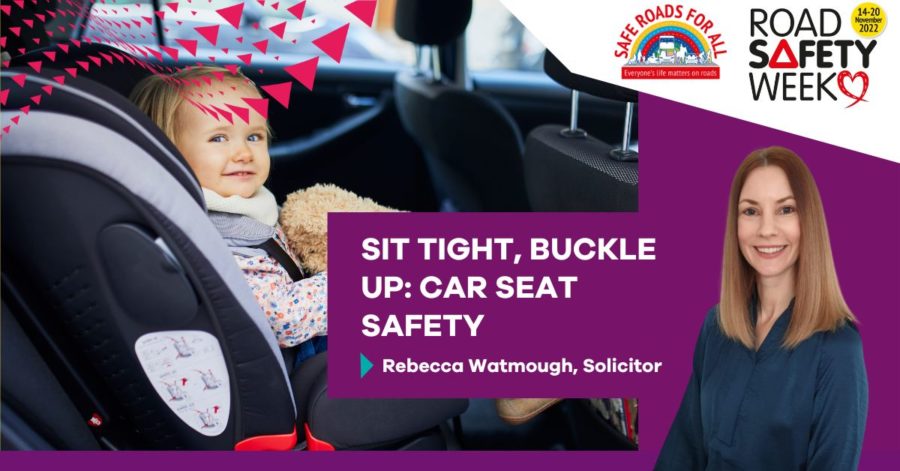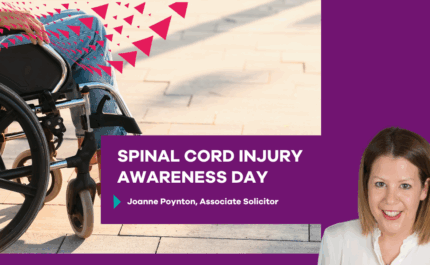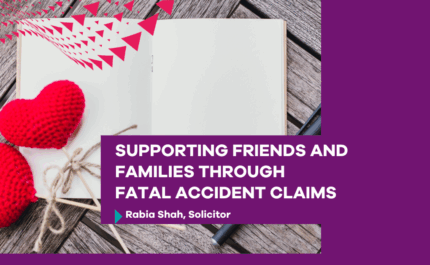
Rebecca Watmough, a solicitor in our Serious Injury Team, and a mother of two young children, considers the importance of car seat safety.
By UK law, all children up to the age of 12 must travel in a car seat. The government guidance states: ‘Children must normally use a child car seat until they’re 12 years old or 135 centimetres tall, whichever comes first. Children over 12 or more than 135cm tall must wear a seat belt.’
Car seat safety is one of the biggest concerns for parents of young children. As a responsible and concerned parent or carer, you want to know that your little one is safe and secure when you’re driving.
One of the most crucial ways parents can keep their child safe is by the proper use of a child safety seat in the car. According to the National Highway Traffic Safety Administration, the leading cause of death in children is motor vehicle accidents.
Not only should children be in car seats appropriate for their age and weight, but they must be properly restrained in those seats.
So firstly, let’s consider baby car seats
Even before your baby is born, you’ll need to buy a car seat. If you do not own a car, you should borrow or hire a car seat when taking your new baby home from the hospital by car or taxi.
Babies must sit in a rear-facing car seat until they are at least 15 months old, to offer extra protection. Baby safety seats use a five-point harness system as a means of restraint. This system ensures the baby is properly positioned in case of an accident.
Many parents opt for a Group 0 (0kg to 10kg) or Group 0+ (0kg to 13kg) seat for their new born, as these are more lightweight and often come with features catered towards overwhelmed new parents, such as stroller wheels or a lie-flat function and can easily be attached to a pushchair chassis with the right adaptors.
Isofix: what is it, and is it worth the cost?
While many car seats can be installed correctly using only the seatbelt, buying an Isofix base, which uses fixed anchor points to secure the seats in place, can be a worthwhile investment.
They’re often more secure and less fiddly than using a seatbelt, and many brands have bases that last across the car seat groups, so they can last many years.
Many bases will have safety indicators which turn from red to green when you have installed them properly which will bring anxious parents’ peace of mind. Before buying a base, make sure it is compatible with your car.
Studies show around 80 per cent of parents incorrectly fit child seats, so it’s worth doing your research and learning how to do it properly.
To make sure your baby is safe in a car seat, it is important that you do the following things:
- Practice fitting the seat into your car first. The Royal Society for the Prevention of Accidents (RoSPA) have some guidance on how to do this safely, and some retailers will be able to help with a car seat fitting demonstration.
- Only use a rear-facing car seat unless you have been told otherwise by a healthcare professional.
- Never use a car seat in the front seat of the car if an active passenger seat airbag is fitted.
- Do not buy or use a second-hand car seat unless you know about its history.
- Never leave your baby alone in the car seat.
- Do not use the seat outside of the car.
- Recline the seat as much as possible when in the car (carefully following the manufacturer’s instructions).
- Avoid the use of padded coats when the baby is in the car seat. Large coats or outerwear can prevent the baby from being secure in the car seat.
- Most newborn car seats come with an insert for more support and padding. It is not recommended to buy separate inserts that do not come with the car seat, as these may not meet safety regulations.
- Keep car journeys short for the first few months, if possible, ideally no longer than 30 minutes. If you need to travel for longer, you should take regular breaks where the baby is taken out of the seat.
Now let’s consider older babies, toddlers, and children
In a bid to keep a watchful eye on children, many parents choose to move their babies into a forward-facing seat as soon as possible, however, as young children are still developing, their neck, head and spine are fragile and, if placed in a forward-facing position too soon, risk injuring these vulnerable areas.
Youngsters should remain in a rear-facing seat until they reach 13kg in weight, or 15 months old in an i-Size seat.
It is always recommended to rear face for as long as possible as tests have shown that this is the safest way for the child to travel.
There are a lot of myths or misconceptions out there about keeping children rear facing over the age of 15 months. Your child will not be “squashed” or not have enough leg room if you continue to rear face – Have you seen that children can have their legs in all sorts of weird positions when playing? Children are much more flexible than adults and thus often do not mind sitting with their legs bent or crossed, and even prefer to do so. It is often us parents who think that it looks uncomfortable, just because it would be for us adults. If your child complains about the leg room, then it is recommended to take frequent breaks during longer journeys so that they can stretch out their legs and get rid of some energy at the same time.
A car seat can either be chosen based on the child’s height or weight as follows:
Height based:
So called ‘i-Size’ seats are chosen based on the height of a child.
Those under 15 months must be placed in a rear-facing car seat until they reach 15 months and can sit in a forward-facing car seat after that.
Weight-based:
- 0kg to 10kg – Group 0 – Lie-flat or ‘lateral’ baby carrier, rear-facing baby carrier, or rear-facing baby seat using a harness
- 0kg to 13kg – 0+ – Rear-facing baby carrier or rear-facing baby seat using a harness
- 9kg to 18kg – 1 – Rear- or forward-facing baby seat using a harness or safety shield
So, when can your child transition to a booster seat, and what is that!?
A booster seat is a seat a child sits on that uses the vehicle’s seat belt as means of restraint. High-back booster seats provide head and neck support in vehicles that do not have a head rest.
Again, readiness for this type of seat depends upon the child’s height and weight:
- 15kg to 25kg – 2 – Rear- or forward-facing child car seat (high-backed booster seat or booster cushion) using a seat belt, harness, or safety shield
- 22kg to 36kg – 3 – Rear- or forward-facing child car seat (high-backed booster seat or booster cushion) using a seat belt, harness, or safety shield
There is no rush to move your child into a booster seat if the five-point harness is working fine.
With a booster seat, the vehicle’s seat belt needs to adjust properly over the child. Booster seats need to be used until the child is large enough and tall enough to be secured by the vehicle’s seat belt.
To determine if the booster is a good fit, caregivers should look to see that when the seat belt is routed and buckled correctly, the lap portion of the belt is low and across the hips and not across the abdomen, the shoulder belt is across the chest and contacts the shoulder and the child is able to remain in the correct position the entire ride.
Now let’s consider some common child car seat mistakes
Along with an inappropriate car seat, there are other mistakes that could also risk the safety of your child. Here, CarMats.co.uk round-up seven of the most common car seat mistakes and how to avoid them.
1. Car seat not installed correctly or securely
An indicator your seat isn’t installed correctly is if the seat is considerably loose. If it can be moved with ease, it may mean that your seat hasn’t been installed properly or that the car seat isn’t compatible with the car. Make sure to follow the manufacturer’s manual that comes with your car seat and thoroughly check its fixture in your car every time it is used.
2. Child is wearing bulky clothes
A snug puffer jacket might keep your child from getting cold, but it could also be a safety risk. The added layers can add extra slack and reduce the defence of the car seat. Instead, you should strap your child in the seat first, then, for added warmth, add a blanket on top after. This ensures that your child is properly strapped in.
3. Adding nonessential toys to the seat
Keeping a young child entertained is no easy task but attaching a toy to a child’s seat can be a safety risk. Unless a toy or accessory came with your seat, or is recommended by the manufacturer, then it shouldn’t be used. Toys when detached from the seat can become a flight risk and cause a distraction while you’re driving.
4. Straps are too loose or too tight
Your seat could be installed perfectly, but if the straps aren’t properly adjusted then your child could be dislodged from the seat, resulting in injury, or worse, in the event of a crash. One way to check the straps are fastened correctly is by doing the pinch test – Simply place your fingers on the harness, where it rests on your child’s collarbone. If the strap material can be pinched together and folded, then this means the harness is too loose. Adjust the strap so the material can no longer be pinched together.
5. Going from rear to forward facing too soon, as touched on above.
6. Forgetting to adjust the strap height when your child grows
Adjusting the harness strap height is not a one-time job, as children grow, so should the height of the harness strap. If the strap height doesn’t match your child’s height, then it can increase the amount your child’s body can move during a crash. It also increases the risk of injury.
Parents should monitor the harness strap height according to their child’s shoulders. In rear-facing seats, the straps should come through the car seat slots below or at the same level as their shoulders. Whereas on forward-facing seats, the straps should be above or at the same level as the shoulders.
7. Moving to a booster seat too soon
Only when a child is mature enough and reaches the height and weight limit of a car seat should they move on to sit in a booster seat. Booster seats will come with weight and height limits, and all vary based on the manufacturer’s instructions. However, there is also a maturity requirement to sit in a booster seat. The general rule is that children over four can ride in a booster seat, however, this is on a case-by-case basis. Even when your child reaches that age, if they can’t stay still in their seat, it may be worth keeping them in a child seat for longer.
And finally, let’s look at any exceptions to the rule
When a child can travel without a car seat
A child aged 3 or older can travel in a back seat without a child car seat and without a seat belt if the vehicle doesn’t have one. In most cases, children under 3 must always be in a child car seat.
The rules are different if:
- the child is in a taxi or minicab
- the child is in a minibus, coach, or van
- the child is on an unexpected journey, for example an emergency
- there’s no room for another car seat
Taxis and minicabs (private hire vehicles)
If the driver doesn’t provide a child car seat, the child can travel without one – but only if they travel on a rear seat:
- and wear an adult seat belt if they’re 3 or older
- without a seat belt if they’re under 3
Minibuses, coaches, and vans
Minibus or coach drivers and companies don’t have to provide child car seats. You must provide your own if you want to make sure a child has one.
Coaches
Children can travel without a child car seat or seat belt if they’re not available.
Minibuses
All children must travel in rear seats (any seats behind the driver) if a child car seat or an adult seat belt isn’t fitted.
Children aged 3 or older must:
- use a child car seat if there’s one available in a minibus
- use an adult seat belt if child car seats are not fitted or are unsuitable
Vans
The rules for vans are the same as for cars.
Unexpected journeys
If the correct child car seat isn’t available, a child aged 3 or older can use an adult seat belt if the journey is all the following:
- unexpected
- necessary
- over a short distance
You can’t take children under 3 on an unexpected journey in a vehicle without the correct child car seat, unless both of the following apply:
- it’s a licensed taxi or minicab
- the child travels on a rear seat without a seat belt
No room for a third child car seat
Children under 3 must be in a child car seat. If there’s no room for a third child car seat in the back of the vehicle, the child must travel in the front seat with the correct child car seat.
Children aged 3 or older can sit in the back using an adult belt.
Source
https://www.gov.uk/child-car-seats-the-rules/when-a-child-can-travel-without-a-car-seat#:~:text=the%20child%20is%20in%20a,room%20for%20another%20car%20seat



